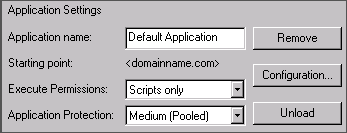What are the application settings for a site in IIS?
The following article details the different application settings for IIS 5 and IIS 6. These settings control various functions of the website, including how memory is handled, the starting point, the execute permissions, and many more. Individual folders within a website can be also be configured as applications.
The application settings are located on the Home Directory tab within the properties of your website in IIS.

These settings give you control over the name, virtual site origin, file permissions, and memory configurations:
- Application name: this is the name of your application (you are not required to give your application a name)
- Starting point: this point represents where the virtual site begins, in either the root of the website or the root of the folder (if the folder is configured as an application)
- Execute Permissions: these permissions control what types of files the website is allowed to run. You have three options:
- None: allows you to run .htm and .html files, but no scripting can be done
- Scripts only: allows you to run .htm and .html files in addition to running ASP, cgi and perl scripts
- Scripts and Executables: allows you to run .htm, .html, cgi, and perl scripts as well as .dll and .exe files
- Application Protection: this protection controls how memory is handled for ASP pages and is handled differently depending on the version of IIS you are running
IIS 5.0
Within IIS 5.0, you have three levels of application protection which determine how memory resources are allocated for ASP pages:
- Low (IIS Process): this level runs ASP pages using the same resources as the web service. The advantage of the low level is that you are given the most permissions and access. The disadvantage is that if the ASP service fails, the web service will be impacted as well.
- Medium (Pooled): this level allocates a pool of memory resources used by all ASP pages. The advantage of the medium level is that you control the amount of resources allocated. In addition, if an ASP page causes the ASP service to fail, it does not affect the web service. The disadvantage is that if one site causes the ASP service to fail, all of the ASP pages will fail.
- High (Isolated): this level allocates a specific amount of memory resources for each ASP application. The advantage to the high level is that if an ASP page causes the ASP service to fail, only that specific site will fail and not the other sites. The disadvantage is that additional resources are used by each individual application pool.
IIS 6.0
Within IIS 6.0, you have the ability to create customer application pools based on the types of pages you are running. The application pool controls how memory is allocated, how worker processes are managed, and other such settings. Each site is then placed within its appropriate application pool.
For example, you can create the following 4 application pools and then set each website within the appropriate pool:
- HTML: memory management is tailored for sites running .htm and .html pages
- ASP: memory management is tailored for sites running ASP pages
- ASP.NET: memory management is tailored for sites running ASP.Net pages
- All Pages: memory management is tailored for sites running a mix of different pages

 Order
Order